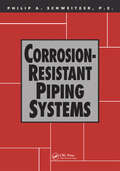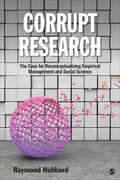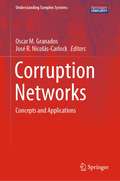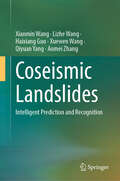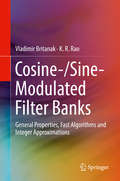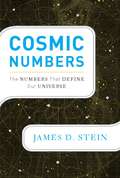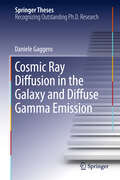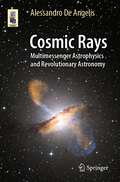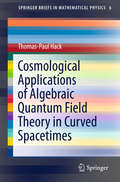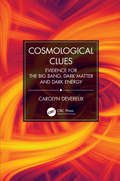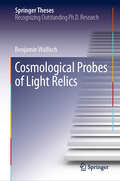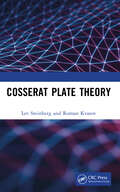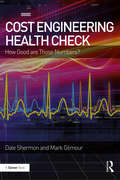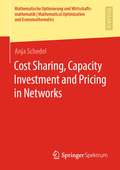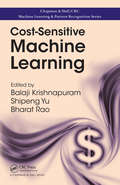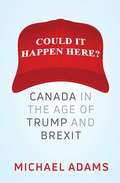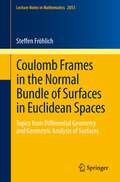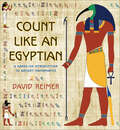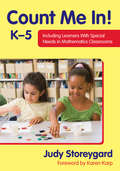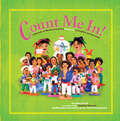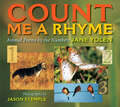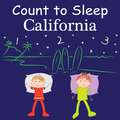- Table View
- List View
Corrosion-Resistant Piping Systems (Corrosion Technology)
by P.E. SchweitzerThis work presents a step-by-step procedure for determining the most suitable piping material for any given situation. It describes all corrosion-resistant piping systems - including thermoset and thermoplastic, lined and metallic systems and miscellaneous systems such as glass, carbon and clay. A compatibility table for each piping system, compiling the corrosion resistance of over 175 common corrodents, is provided.
Corrupt Research: The Case for Reconceptualizing Empirical Management and Social Science
by Raymond HubbardAddressing the immensely important topic of research credibility, Raymond Hubbard’s groundbreaking work proposes that we must treat such information with a healthy dose of skepticism. This book argues that the dominant model of knowledge procurement subscribed to in these areas—the significant difference paradigm—is philosophically suspect, methodologically impaired, and statistically broken. Hubbard introduces a more accurate, alternative framework—the significant sameness paradigm—for developing scientific knowledge. The majority of the book comprises a head-to-head comparison of the "significant difference" versus "significant sameness" conceptions of science across philosophical, methodological, and statistical perspectives.
Corrupt Research: The Case for Reconceptualizing Empirical Management and Social Science
by Raymond HubbardAddressing the immensely important topic of research credibility, Raymond Hubbard’s groundbreaking work proposes that we must treat such information with a healthy dose of skepticism. This book argues that the dominant model of knowledge procurement subscribed to in these areas—the significant difference paradigm—is philosophically suspect, methodologically impaired, and statistically broken. Hubbard introduces a more accurate, alternative framework—the significant sameness paradigm—for developing scientific knowledge. The majority of the book comprises a head-to-head comparison of the "significant difference" versus "significant sameness" conceptions of science across philosophical, methodological, and statistical perspectives.
Corruption Networks: Concepts and Applications (Understanding Complex Systems)
by Oscar M. Granados José R. Nicolás-CarlockThis book aims to gather the insight of leading experts on corruption and anti-corruption studies working at the scientific frontier of this phenomenon using the multidisciplinary tools of data and network science, in order to present current theoretical, empirical, and operational efforts being performed in order to curb this problem. The research results strengthen the importance of evidence-based approaches in the fight against corruption in all its forms, and foster the discussion about the best ways to convert the obtained knowledge into public policy.The contributed chapters provide comprehensive and multidisciplinary approaches to handle the non-trivial structural and dynamical aspects that characterize the modern social, economic, political and technological systems where corruption takes place.This book will serve a broad multi-disciplinary audience from natural to social scientists, applied mathematicians, including law and policymakers.
Coseismic Landslides: Intelligent Prediction and Recognition
by Lizhe Wang Xuewen Wang Xianmin Wang Haixiang Guo Qiyuan Yang Aomei ZhangFocusing on Habitable Earth for sustainability, this book develops novel and sophisticated deep learning algorithms and explores their successful application in intelligent prediction and recognition of coseismic landslides. These algorithms have originality and unique advantages in relatively high accuracy, low false alarms, strong generalization, and good interpretability. They were successfully applied in a series of violent earthquakes occurring worldwide from 2008 to 2022. This book provides significant techniques to support the 72-hour &“golden window&” for survivors in emergency rescue and to instruct postseismic rational reconstruction and development in society and economy. With cutting-edge algorithms and international urgent disaster-mitigating demands, this book caters to geoscientists, environmentalists, engineering geologists, and hazard geologists. It also appeals graduate students in the above fields.
Cosine-/Sine-Modulated Filter Banks: General Properties, Fast Algorithms and Integer Approximations
by K. R. Rao Vladimir BritanakThis book covers various algorithmic developments in the perfect reconstruction cosine/sine-modulated filter banks (TDAC-MDCT/MDST or MLT, MCLT, low delay MDCT, complex exponential/cosine/sine-modulated QMF filter banks), and near-perfect reconstruction QMF banks (pseudo-QMF banks) in detail, including their general mathematical properties, matrix representations, fast algorithms and various methods to integer approximations being recently a new transform technology for lossless audio coding. Each chapter will contain a number of examples and will conclude with problems and exercises. The book reflects the research efforts/activities and achieved results of the authors in the time period over the last 20 years.
Cosmic Catastrophes
by J. Craig WheelerFrom supernovae and gamma-ray bursts to the accelerating Universe, this is an exploration of the intellectual threads that lead to some of the most exciting ideas in modern astrophysics and cosmology. This fully updated second edition incorporates new material on binary stars, black holes, gamma-ray bursts, worm-holes, quantum gravity and string theory. It covers the origins of stars and their evolution, the mechanisms responsible for supernovae, and their progeny, neutron stars and black holes. It examines the theoretical ideas behind black holes and their manifestation in observational astronomy and presents neutron stars in all their variety known today. This book also covers the physics of the twentieth century, discussing quantum theory and Einstein's gravity, how these two theories collide, and the prospects for their reconciliation in the twenty-first century. This will be essential reading for undergraduate students in astronomy and astrophysics, and an excellent, accessible introduction for a wider audience.
Cosmic Numbers: The Numbers That Define Our Universe
by James D. SteinStein (mathematics, California State U. ) recounts the stories of how famous mathematicians and physicists discovered numerical constants and equations that define the laws of physical science and astronomy. Appropriate for the general reader with a basic understanding of algebra, the 13 chapters explain the logic behind the speed of light, the ideal gas constant, absolute zero, Avogadro's number, the Planck constant, the Schwarzschild radius, and the Chandrasekhar limit. Annotation ©2011 Book News, Inc. , Portland, OR (booknews. com)
Cosmic Ray Diffusion in the Galaxy and Diffuse Gamma Emission (Springer Theses)
by Daniele GaggeroThe original work presented in this thesis constitutes an important contribution to modern Cosmic Ray (CR) physics, and comes during one of the most exciting periods of this field. The first part introduces a new numerical code (DRAGON) to model the CR propagation in our Galaxy. The code is then used to perform a combined analysis of CR data, making it possible to determine their propagation properties with unprecedented accuracy. The second part is dedicated to a theoretical interpretation of the recent crucial experimental results on cosmic electron and positron spectra (PAMELA, Fermi-LAT experiments). Using the tools developed in the first part of the thesis, the author convincingly argues for the existence of a new spectral component, which could arise either from local astrophysical sources, such as pulsars, or from Dark Matter annihilation or decay. This thesis is a highly advanced work; the methods, analysis and results are clearly and carefully presented. This work is set to become an important reference document for any future work in this area.
Cosmic Rays: Multimessenger Astrophysics and Revolutionary Astronomy (Astronomers' Universe)
by Alessandro De AngelisIn recent years, cosmic rays have become the protagonists of a new scientific revolution. We are able today to film the Universe with telescopes of completely novel conception, recording information from many different messengers and accessing previously unknown cosmic regions.Written by a recognized authority in physics, this book takes readers on a captivating journey through the world of cosmic rays, their role in the revolutionary field of multi-messenger astronomy, their production from powerful accelerators close to the surfaces of black holes and compact objects, reaching the highest levels of energy observed in nature, and the implications this has for our understanding of the Universe. Through the stories of pioneering scientists, explorations of cutting-edge technologies, and simple explanations related to particle physics, quantum mechanics, and astrophysics, the book provides an illuminating state-of-the-art introduction to the current state of high-energy astrophysics. The book was written in straightforward yet rigorous language, so as to be accessible to the greater public. For those curious about the cosmos and cosmic gamma rays, nuclei, neutrinos, and gravitational waves, from casual observers to professional astronomers and physicists, the book is a must-read, offering a thrilling adventure into the future of astronomy and particle physics.
Cosmological Applications of Algebraic Quantum Field Theory in Curved Spacetimes (SpringerBriefs in Mathematical Physics #6)
by Thomas-Paul HackThis book provides a largely self-contained and broadly accessible exposition on two cosmological applications of algebraic quantum field theory (QFT) in curved spacetime: a fundamental analysis of the cosmological evolution according to the Standard Model of Cosmology; and a fundamental study of the perturbations in inflation. The two central sections of the book dealing with these applications are preceded by sections providing a pedagogical introduction to the subject. Introductory material on the construction of linear QFTs on general curved spacetimes with and without gauge symmetry in the algebraic approach, physically meaningful quantum states on general curved spacetimes, and the backreaction of quantum fields in curved spacetimes via the semiclassical Einstein equation is also given. The reader should have a basic understanding of General Relativity and QFT on Minkowski spacetime, but no background in QFT on curved spacetimes or the algebraic approach to QFT is required.
Cosmological Clues: Evidence for the Big Bang, Dark Matter and Dark Energy
by Carolyn DevereuxDid the Universe have a beginning? Will it have an end? Or has it always been the same, never changing? This is the subject of cosmology; the study of the Universe, and this book provides a perfect introduction to the subject for anyone that is interested in the wonders of our UniverseThis book provides an accessible overview of the Standard Model of Cosmology, which is explained in six Cosmological Clues, including evidence for the Big Bang and dark matter and dark energy - the keystones of modern cosmology. It takes readers through some of the most exciting questions in cosmology, such as what evidence do we have that the Universe started from the Big Bang? Has dark matter been observed? Will we ever know what dark energy is? Are the multiverses real? And could the Universe be a hologram? This book is an ideal guide for anyone interested in finding out more about our Universe. It will be of interest to those studying cosmology for the first time, including readers without a scientific background, who have an interest in looking up at the stars and wondering where they all came from!Key features: Contains the latest evidence for the Big Bang, dark matter, and dark energy and explores exciting scientific ideas, such as inflation and multiverses Provides a clear explanation of the main theories of how the Universe evolved based on key observations - the Cosmological Clues Gives the reader a concise introduction to the scientific process, using cosmology as the example, and explores why it has been so successful in creating the technologies we have today
Cosmological Probes of Light Relics (Springer Theses)
by Benjamin WallischThe wealth of recent cosmic microwave background and large-scale structure data has transformed the field of cosmology. These observations have not only become precise enough to answer questions about the universe on the largest scales, but also to address puzzles in the microscopic description of Nature. This thesis investigates new ways of probing the early universe, the properties of neutrinos and the possible existence of other light particles. In particular, based on detailed theoretical insights and novel analyses, new evidence for the cosmic neutrino background is found in the distribution of galaxies and in cosmic microwave background data. This tests the Standard Model of particle physics and the universe back to a time when it was about one second old. Furthermore, it is demonstrated that future observations will be capable of probing physics beyond the Standard Model since they can achieve a particular target which would either allow the detection of any light particles that have ever been in thermal equilibrium or imply strong bounds on their properties.
Cosserat Plate Theory
by Lev Steinberg Roman KvasovThis book presents the foundation and validation of the Cosserat Plate Theory, numerical experiments of deformation and vibration, and the unique properties of the Cosserat plates. Our approach incorporates the high accuracy assumptions of the Cosserat plate deformation consistent with the Cosserat Elasticity equilibrium equations, constitutive formulas, strain-displacement and torsion-microrotation relations. The Cosserat Plate Theory is parametric, where the "splitting parameter" minimizes the Cosserat plate energy. The validation of the theory is based on the comparison with the three-dimensional Cosserat Elastostatics and Elastodynamics. The numerical results are obtained using the Finite Element Method (FEM) specifically developed to solve the parametric system of equations. The analysis of deformation of a variety of Cosserat plates shows the stress concentration reduction, higher stiffness of Cosserat plates, and the size-effect related to the microstructure. The analysis of vibration of Cosserat plates predicts size-related properties of the plate vibration, the existence of the additional so-called Cosserat plate resonances, and the dynamic anisotropy, related to the dependency of the resonances on the microelement's shapes and orientations.
Cost Engineering Health Check: How Good are Those Numbers?
by Dale Shermon Mark GilmourHigh quality cost estimating gives a business leader confidence to make rational financial decisions. Whether you are a business leader or a cost estimating manager, you have a vested interest in understanding whether you can depend on your organisation's ability to generate accurate cost forecasts and estimates. But how can business leaders have confidence that the cost information that they are being provided with is of high quality? How can a cost estimating manager be sure that their team is providing high quality cost information? QinetiQ's Cost Engineering Health Check is used as a capability benchmarking tool to identify improvement opportunities within their clients' cost estimating capability, enabling them to focus on areas that have the potential to increase their competitiveness. High quality estimating leads to accurate budgets, a reduced potential for cost growth, accurate evaluation of risk exposure, and the opportunity to implement effective earned value management (EVM). The Cost Engineering Health Check employs a standardised competency framework that considers all aspects of cost estimating capability, and provides an objective assessment against both best practice and the industry standard. This framework is based on QinetiQ's long established, tried and tested, Knowledge Based Estimating (KBE) philosophy comprising Data, Tools, People and Process, with additional consideration given to cultural and stakeholder assessments.
Cost Sharing, Capacity Investment and Pricing in Networks (Mathematische Optimierung und Wirtschaftsmathematik | Mathematical Optimization and Economathematics)
by Anja SchedelAnja Schedel analyzes two models in the field of algorithmic game theory which both constitute bilevel problems in networks. The first model is a game-theoretic variant of the well-known Steiner forest problem, and one is interested in an optimal sharing of the cost of the Steiner forest. The author provides (and partially exactly characterizes) network structures which allow for cost-minimal pure Nash equilibria. The second model is motivated from privatized public roads, in which private, selfishly acting firms build roads, and as compensation for their investment, are allowed to set prices for using the roads. For a basic model of this situation, the author shows existence and uniqueness of pure Nash equilibria. The existence result requires a non-standard proof approach since techniques like Kakutani’s fixed point theorem cannot be applied directly.
Cost-Sensitive Machine Learning
by Bharat Rao Balaji Krishnapuram Shipeng YuIn machine learning applications, practitioners must take into account the cost associated with the algorithm. These costs include: Cost of acquiring training dataCost of data annotation/labeling and cleaningComputational cost for model fitting, validation, and testingCost of collecting features/attributes for test dataCost of user feedback collect
Could It Happen Here?: Canada in the Age of Trump and Brexit
by Michael AdamsFrom award-winning author Michael Adams, Could It Happen Here? draws on groundbreaking new social research to show whether Canadian society is at risk of the populist forces afflicting other parts of the world.Americans elected Donald Trump. Britons opted to leave the European Union. Far-right, populist politicians channeling anger at out-of-touch “elites” are gaining ground across Europe. In vote after shocking vote, citizens of Western democracies have pushed their anger to the top of their governments’ political agendas. The votes have varied in their particulars, but their unifying feature has been rejection of moderation, incrementalism, and the status quo. Amid this roiling international scene, Canada appears placid, at least on the surface. As other societies retrench, the international media have taken notice of Canada’s welcome of Syrian refugees, its half-female federal cabinet, and its acceptance of climate science and mixed efforts to limit its emissions. After a year in power, the centrist federal government continues to enjoy majority approval, suggesting an electorate not as bitterly split as the ones to the south or in Europe. As sceptics point out, however, Brexit and a Trump presidency were unthinkable until they happened. Could it be that Canada is not immune to the same forces of populism, social fracture, and backlash that have afflicted other parts of the world? Our largest and most cosmopolitan city elected Rob Ford. Conservative Party leadership hopeful Kellie Leitch proposes a Canadian values test for immigrants and has called the Trump victory “exciting.” Anti-tax demonstrators in Alberta chanted “lock her up” in reference to Premier Rachel Notley, an elected leader accused of no wrongdoing, only policy positions the protesters disliked. Pollster and social values researcher Michael Adams takes Canadians into the examining room to see whether we are at risk of coming down with the malaise affecting other Western democracies. Drawing on major social values surveys of Canadians and Americans in 2016—as well as decades of tracking data in both countries—Adams examines our economy, institutions, and demographics to answer the question: could it happen here?
Coulomb Frames in the Normal Bundle of Surfaces in Euclidean Spaces: Topics from Differential Geometry and Geometric Analysis of Surfaces (Lecture Notes in Mathematics #2053)
by Steffen FröhlichThis book is intended for advanced students and young researchers interested in the analysis of partial differential equations and differential geometry. It discusses elementary concepts of surface geometry in higher-dimensional Euclidean spaces, in particular the differential equations of Gauss-Weingarten together with various integrability conditions and corresponding surface curvatures. It includes a chapter on curvature estimates for such surfaces, and, using results from potential theory and harmonic analysis, it addresses geometric and analytic methods to establish the existence and regularity of Coulomb frames in their normal bundles, which arise as critical points for a functional of total torsion.
Count Like an Egyptian: A Hands-on Introduction to Ancient Mathematics
by David ReimerA lively collection of fun and challenging problems in ancient Egyptian mathThe mathematics of ancient Egypt was fundamentally different from our math today. Contrary to what people might think, it wasn't a primitive forerunner of modern mathematics. In fact, it can’t be understood using our current computational methods. Count Like an Egyptian provides a fun, hands-on introduction to the intuitive and often-surprising art of ancient Egyptian math. David Reimer guides you step-by-step through addition, subtraction, multiplication, and more. He even shows you how fractions and decimals may have been calculated—they technically didn’t exist in the land of the pharaohs. You’ll be counting like an Egyptian in no time, and along the way you’ll learn firsthand how mathematics is an expression of the culture that uses it, and why there’s more to math than rote memorization and bewildering abstraction.Reimer takes you on a lively and entertaining tour of the ancient Egyptian world, providing rich historical details and amusing anecdotes as he presents a host of mathematical problems drawn from different eras of the Egyptian past. Each of these problems is like a tantalizing puzzle, often with a beautiful and elegant solution. As you solve them, you’ll be immersed in many facets of Egyptian life, from hieroglyphs and pyramid building to agriculture, religion, and even bread baking and beer brewing.Fully illustrated in color throughout, Count Like an Egyptian also teaches you some Babylonian computation—the precursor to our modern system—and compares ancient Egyptian mathematics to today’s math, letting you decide for yourself which is better.
Count Me In! K–5: Including Learners With Special Needs in Mathematics Classrooms
by Judith S. StoreygardHow to make math add up for all students Between the pressure to meet standards and the overwhelming number of different learning needs that students have, planning lessons has become more complex. Many resources help teachers address literacy needs, but few address mathematics. Using research-based and field-tested methodology, this book provides proven approaches to understanding behaviors and creating teaching programs. Key topics include: Strategies for teaching students with autism, ADHD, and various learning disabilities Ways to develop students’ cognitive flexibility How to help learners plan, organize and self-monitor in mathematics class A new focus on mathematical strengths and learning ability rather than on deficits and labels
Count Me In!: A Parade of Mexican Folk Art Numbers in English and Spanish (First Concepts in Mexican Folk Art)
by Cynthia WeillHandcrafted clay figures from Oaxaca, Mexico, invite children to join a parade as they count from one to ten in English and Spanish. Figuras de barro hechas a mano en Oaxaca, México, invitan a los niños a unirse a un desfile mientras cuentan del uno al diez en inglés y español.Here comes the parade! Young readers practice number words and counting in English and Spanish as musicians, dancers, "giants," and more march by. One/Uno band leader carries a big white balloon. Two/dos men bring fireworks. Three/tres musicians play their instruments. All the way to ten/diez more onlookers who join the Guelaguetza parade. Guelaguetza is a cultural event that takes place every July in Oaxaca, Mexico. This lively celebration is joyously depicted in this book by a simple storyline and a parade of fun, colorful, handcrafted clay figures for children to enjoy and count. ¡Aquí viene el desfile! Los lectores jóvenes practican palabras numéricas y cuentan en inglés y español mientras músicos, bailarines, "gigantes" y más marchan. El líder de la banda uno/one lleva un gran globo blanco. Dos/two hombres traen fuegos artificiales. Tres/three músicos tocan sus instrumentos. Todo el camino a diez/ten más espectadores que se suman al desfile de la Guelaguetza. La Guelaguetza es un evento cultural que se lleva a cabo cada mes de julio en Oaxaca, México. Esta animada celebración está alegremente representada por una historia simple y un desfile de figuras de arcilla hechas a mano, coloridas y divertidas para que los niños disfruten y cuenten.
Count Me a Rhyme: Animal Poems by the Numbers
by Jane YolenThis delightful counting book of poetry and pictures on the Texas 2x2 Reading List captures animals by the numbers. Vivid, playful poems tell the stories of one elk, two birds, three fish—from one through ten and then many—as they go about their day either solo or within a special circle of friends. The marvelous photographs allows readers to peek at some common creatures that enjoy the company of others.
Count On Us: A Tennessee Number Book
by Michael ShouldersThis fun colorful, and superbly informative book teaches children about numbers using recognizable places, events, and facts from the state of Tennessee. As elementary students grasp the concept and visual of 30 purple passion flowers, they'll also learn that the passion flower is the state wildflower and that Native Americans in Tennessee used the plants to help heal cuts and bruises. Numbers throughout the book are explained with a simple rhyme for younger children and are accompanied by detailed expository text for older learners.
Count To Sleep California (Count To Sleep)
by Adam Gamble Mark JasperMaking basic numbers fun to learn, this board book teaches kids to count to 10 using famous California icons and landmarks. Featuring whimsical illustrations, this concept books is a terrific way to introduce young children to cherished destinations in California while easing them to sleep at naptime or bedtime. The Pacific Ocean, Golden Gate Bridge, Hollywood, sea lions, Napa Valley, the Sierra Nevada Mountains, and Yosemite National Park are all included in this playful counting book.
